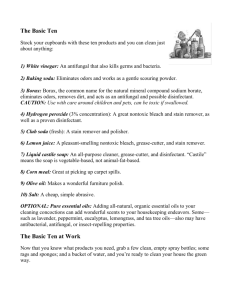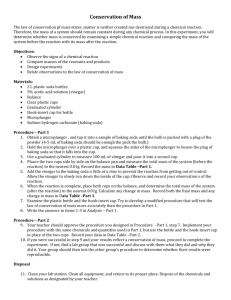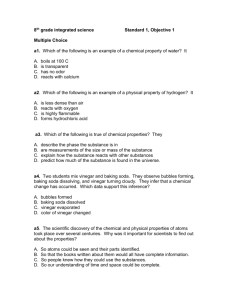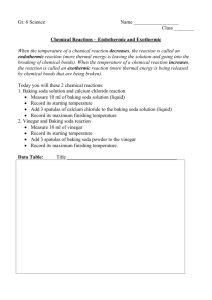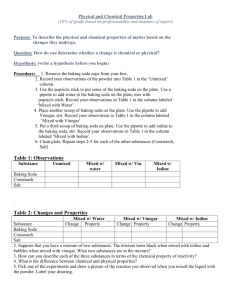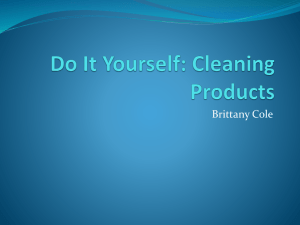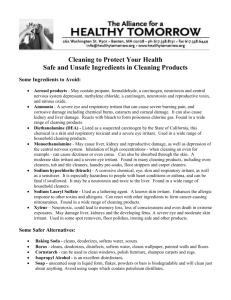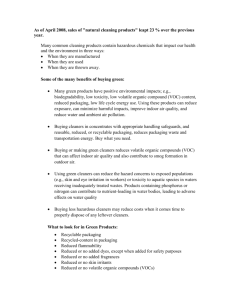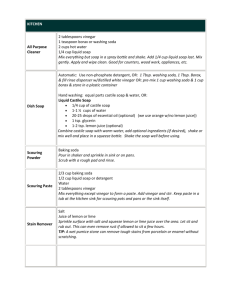Cons
advertisement
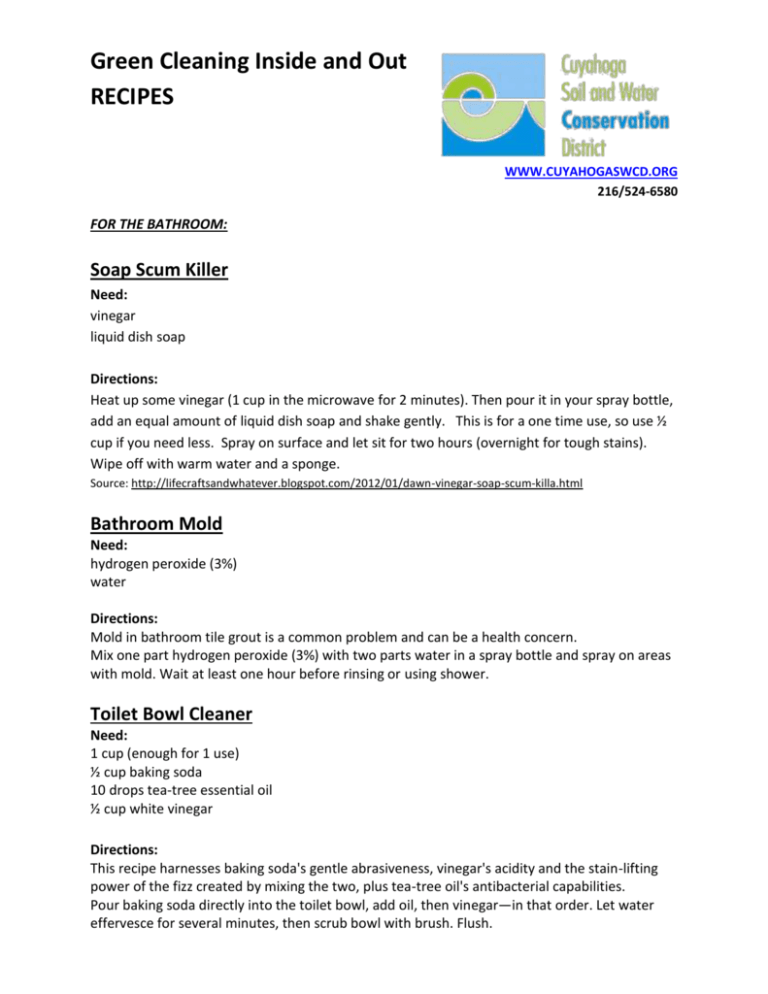
Green Cleaning Inside and Out RECIPES WWW.CUYAHOGASWCD.ORG 216/524-6580 FOR THE BATHROOM: Soap Scum Killer Need: vinegar liquid dish soap Directions: Heat up some vinegar (1 cup in the microwave for 2 minutes). Then pour it in your spray bottle, add an equal amount of liquid dish soap and shake gently. This is for a one time use, so use ½ cup if you need less. Spray on surface and let sit for two hours (overnight for tough stains). Wipe off with warm water and a sponge. Source: http://lifecraftsandwhatever.blogspot.com/2012/01/dawn-vinegar-soap-scum-killa.html Bathroom Mold Need: hydrogen peroxide (3%) water Directions: Mold in bathroom tile grout is a common problem and can be a health concern. Mix one part hydrogen peroxide (3%) with two parts water in a spray bottle and spray on areas with mold. Wait at least one hour before rinsing or using shower. Toilet Bowl Cleaner Need: 1 cup (enough for 1 use) ½ cup baking soda 10 drops tea-tree essential oil ½ cup white vinegar Directions: This recipe harnesses baking soda's gentle abrasiveness, vinegar's acidity and the stain-lifting power of the fizz created by mixing the two, plus tea-tree oil's antibacterial capabilities. Pour baking soda directly into the toilet bowl, add oil, then vinegar—in that order. Let water effervesce for several minutes, then scrub bowl with brush. Flush. FOR ANY SINK/TUB DRAIN IN HOUSE: Drain Cleaner Need: 2 cups baking soda 4 cups boiling water 1 cup white vinegar Directions: Pour 1 cup baking soda down drain. Pour 2 cups boiling water down drain. Wait a few minutes as baking soda mixed with boiling water dissolves the gunk in the pipe. Pour remaining 1 cup of baking soda down the drain and then 1 cup of white vinegar and plug the drain immediately (if double sink, plug both drains). You’ll hear sizzling and see bubbles foaming up. Wait until bubbles die down and add remaining boiling water. Repeat process if necessary. FOR THE KITCHEN: Homemade Dishwasher Soap (soft water recipe) Need: 1/2 cup borax 1/2 cup washing soda 1/4 cup food grade citric acid * for hard water, try increasing the amount of borax or add 1/4 cup course kosher salt, not regular salt! Directions: Combine ingredients and use sparingly. Use only about 1 to 1 1/2 tsp. per load. (For hard water, you may need more.) Keep in a handy container near your appliance. Source: http://homesteadrevival.blogspot.com/2010/07/homemade-dishwasher-soap.html EARTH SHAKER – Kitchen Cleanser Need: baking soda and an essential oil for fragrance Directions: Fill a plastic flip-top shaker bottle half full with baking soda. Add 15-20 drops of pure essential lemon (or lime) oil. Stir. Fill the shaker to the top with more baking soda. Put the lid on and shake to mix. Shake onto surfaces then with a damp sponge. Rinse well. Source: book - Clean House, Clean Planet by Karen Logan FOR FURNITURE: DUST TO DUST – Furniture polish Need: light olive oil white distilled vinegar pure essential lemon oil or lemon juice water Directions: Put 2 teaspoons of olive oil in a 16 oz. spray bottle. Add 20 drops of lemon oil. Add ¼ cup white distilled vinegar. Fill the rest of the bottle with purified water and shake well. Spray on rag or directly onto furniture. Wipe dry immediately. Source: book - Clean House, Clean Planet by Karen Logan FOR ALL AROUND THE HOUSE: MOMMA’S EARTH CLEANER – Cleaning Spray Need: 8 ounces white distilled vinegar 8 ounces water 15-20 drops essential oil for fragrance Directions: Fill a 16 oz. spray bottle with equal amounts white distilled vinegar and water. Add 15-20 drops of pure peppermint (or other) oil. Shake to mix. Spray directly onto surfaces and wipe clean. Source: book - Clean House, Clean Planet by Karen Logan FOR THE YARD: WEED KILLER Need: 2 cups vinegar ¼ tablespoon dishwashing liquid Directions: Add ¼ tablespoon dishwashing liquid to a 16-24 ounce spray bottle. Then add two cups vinegar. Invert once to mix. Spray directly onto weeds. Weeds should be dead within 24 hours. FOR THE YARD: FUNGICIDE Need: 1 teaspoon baking soda 16 ounce water ¼ teaspoon liquid soap Directions: Common baking soda is a natural fungicide. Mix 1 teaspoon of baking soda with 16 ounces of water. Add ¼ teaspoon of liquid soap and thoroughly blend the mix. Apply it weekly to all parts of the plant to control powdery mildew and black spot. Monitor plants for any cellular damage from the detergent. PESTICIDE INSECTICIDAL SOAP Need: 1 teaspoon dishwashing liquid 4 cups water Directions: Mix 1 teaspoon dishwashing liquid, not a detergent, in 4 cups of water. You only need about 1 percent soap solution to be effective and you do not need oil or anything else. What makes the insecticidal soap effective is that the fatty acids from the animal fats the soap is made from (which is why you need real soap and not a detergent) dissolve the target insect’s exoskeleton. Spray the plant completely, including the stem and even the underside of the leaves as soon as you see problem bugs. Try not to wait to see if the problem resolves itself or you could end up with a full infestation, which is much harder to fix. Other Outdoor Resources: Many natural pesticide recipes are targeted to a specific insect. So the following websites have many recipes you could make depending on the insect species of concern, and/or the plant getting affected. Natural Homemade Pesticides: Recipes and Tips - http://tipnut.com/natural-pesticides/ Natural Pesticidal and Fungicidal Recipes: http://faq.gardenweb.com/faq/lists/organic/2002081329023823.html FOR THE OUTSIDE PAVEMENT: WINTER DE-ICER: Anything you can do to reduce salt use can add up to a substantial improvement in water quality. Salty storm water runoff can poison fish and aquatic organisms and kill sensitive vegetation, not to mention the mining and transport of salt. The Bay Area Storm Water Authority (BASWA) and Michigan Department of Environmental Quality have some suggestions people can take to reduce their salt use: Check the label for de-icers that use calcium chloride, which works at lower temperatures and doesn't contain cyanide like sodium chloride, or rock salt. Potassium chloride is another good choice, since plants can take up the potassium as a nutrient. Pet owners should check out a product called Safe Paw, which won't harm animals like salt products can. Whatever you choose, check the directions and apply sparingly, for the sake of your concrete and the environment. For calcium chloride, about a handful is needed for every three square yards. Guide provided by BASWA: Calcium Magnesium Acetate (CMA) Works at temperatures down to 22°F Pros: Less toxic Calcium Chloride (CaCl) Works at temperatures down to -25°F Pros: Can use lower doses, no cyanide Cons: Chloride impact Urea Works at temperatures down to 20°F Pros: Less corrosion Cons: Adds needless nutrients Sand No melting effect Cons: Accumulates in streets and streams Sodium Chloride (NaCl, traditional rock salt) Works at temperatures down to 15°F Cons: Contains cyanide, chloride impact Source: Envirocast, funded by U.S. Environmental Protection Agency. http://blog.mlive.com/watershedwatch/2009/01/picking_the_right_deicing_prod.html
